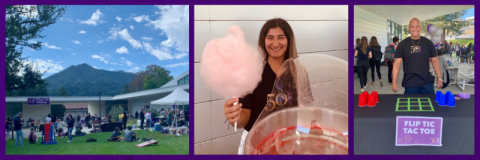Program helps historically underrepresented college students reach their educational goals

Today, community colleges across California are celebrating 50 years since the passage of Senate Bill 164 (Alquist), which legislated the creation of Extended Opportunity Programs and Services (EOPS). Since 1969, EOPS has helped millions of low-income, first-generation, historically underrepresented college students reach their educational goals.
Born out of the Civil Rights Movement, EOPS is considered by many to be the original equity program in California community colleges. With equity as the cornerstone, EOPS at College of Marin provides academic, financial, and personal support for low-income students whose educational and socio-economic backgrounds might otherwise prevent them from successfully attaining their educational goals.
As director of EOPS, CalWORKs, and CARE, Becky Reetz has witnessed the difference this program makes in the lives of students who are all striving to better themselves through education.
“Every EOPS student brings their unique story and set of circumstances,” says Reetz. “Some are immigrants or refugees who fled war-torn countries in search of a better life. Others were born into generational poverty and struggle with homelessness and hunger. Some are single parents working extra hard to educate themselves while living in one of the most expensive counties in the United States.”
The one thing they all have in common is their determination to create a better future for themselves and their families through higher education. EOPS is one place these students find common ground and support.
To celebrate the 50th anniversary, College of Marin’s EOPS staff served a free barbecue lunch to students, faculty, and staff—complete with music, a photo booth, and carnival games.
EOPS HISTORICAL FAST FACTS
- The first transfer center originated from EOPS, with the overriding efforts to provide students with exposure to various transfer institutions. Most colleges in the state now include a transfer center as part of their core of student services.
- Likewise, tutorial assistance programs began in EOPS with the recognition that underprepared and disadvantaged EOPS students could benefit dramatically from tutoring and learning assistance programs. Today, virtually all community colleges in California have tutoring programs.
- Matriculation has as its model EOPS with component activities in assessment, orientation, admissions, outreach, counseling, and program evaluation.
- Blanch G. Goldstein founded Cooperative Agencies Resources for Education (CARE) as an EOPS “special project” at Imperial Valley College in San Diego in 1977. Several years later, it spread to 13 campuses. In 1982, Senator Theresa Hughes authored AB 3103, championed by Capitol staffer William ‘Bill’ Chavez, establishing CARE in California community colleges. Today, CARE exists in all 114 physical campuses.
- EOPS’ strong outcomes and commitment to serve vulnerable populations was further acknowledged when the governor signed legislation to include CAFYES/NextUp into EOPS, establishing it as a new categorical component program of EOPS to provide additional support to eligible former and current foster youth.
- Born out of the Civil Rights Movement, EOPS has a 50-year, data-driven, verifiable track-record of serving students with educational and economic disadvantages.
